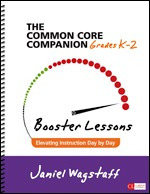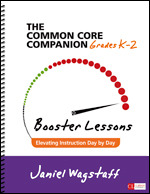The Common Core Companion: Booster Lessons, Grades K-2
Elevating Instruction Day by Day
Corwin Literacy
English/Language Arts Common Core | Reading (Primary/Elementary) | Writing (Primary/Elementary)
You can find hundreds of literacy lessons in hundreds of places—but none of them will do for students what the ones in this book do. What’s the magic bullet? Potent integration.
In this much-anticipated sequel to the K-2 Common Core Companion, Janiel Wagstaff provides an ample supply of connected lessons you can use as booster shots when your students are in need of a good dose of integrated, standards-aligned reading and writing instruction.
Divided into five weeklong learning sequences, the 50 lessons span the ELA standards, bringing a Monday-through-Friday clarity to the sometimes mysterious process of skill-building through demonstrations and practice. Follow each sequence and week by week, you’ll build the instructional potency to help students achieve a year’s worth of growth as you integrate:
- Writing Narratives with Identifying Sensory Words in Text
- Research with Identifying Topic and Details
- Opinion Writing with Close Reading for Text Evidence
- Comparing and Contrasting with Publishing Using Digital Tools
- Informative Writing with Use of Text Features
Each of the 50 lessons is eminently dippable. But if you want to do more extended instructional planning, there are lots of additional tools—including lists of mentor texts, and If/Then and Extending-the-Work charts—within the book and on the companion website: www.corwin.com/commoncorecompanion.
Free resources

Reading Mentor Texts for Parts of a Letter
The first part of this lesson from The Common Core Companion Booster Lessons, Grades K-2, explores reading mentor texts for parts of a letter; the second part shows how to use interactive writing to inform about and present knowledge.
"Like an amazing orchestra conductor, Janiel Wagstaff makes reading and writing instruction symphonic. She shows teachers how to lead their young learners each day, with teaching strategies and routines that develop students’ oral language, comprehension, and writing skills. Teachers and coaches in the primary grades have been waiting for a big book of lessons like this, and whew, here it is. Proof that K-2 literacy instruction can be developmentally appropriate and potent at the same time."
"I almost love this book as much as Janiel Wagstaff herself. What a treasure trove of daily lessons! Wagstaff provides a blueprint for teachers that will definitely make their lives easier. Any reading teacher interested in inspiring students to become more passionate and adamant readers needs this book."
“With personal insights and energy, Janiel Wagstaff provides effective and powerful demonstrations for how to link reading and writing instruction. She discusses ways to make writing more personal, and provides clear minilessons that work. Whether you are an experienced educator or new to the profession, you will appreciate these daily lessons that are certain to boost your students’ reading and writing abilities.”
“With personal insights and energy, Janiel Wagstaff provides effective and powerful demonstrations for how to link reading and writing instruction. She discusses ways to make writing more personal, and provides clear minilessons that work. Whether you are an experienced educator or new to the profession, you will appreciate these daily lessons that are certain to boost your students’ reading and writing abilities.”
“Janiel thinks of everything! The reading and writing lessons are classroom-tested, engaging, and you can practically see and hear the young learners 'getting it'. The 'goods' that make it workable in any classroom include mentor texts, student writing samples, master teacher tips, IF/THEN support for a range of learning outcomes, lesson extensions, and suggestions for differentiation. A welcome resource, providing step-by-step method for introducing the Common Core standards to primary grade students.”
"This book makes me particularly hopeful. It is grounded in sound research and theory, but is wholly practical and accessible. It lays out a clear mandate (too long lost) to have students communicate as much as possible like experts in a discipline. It encourages teachers to join students in probing the capacity of each discipline, in its own way, to help students think, inquire, solve problems, collaborate—and answer the question, “What is life, and who am I in it?” This is Disciplinary Literacy encourages us as teachers to rediscover the complexities teaching and learning and to reinvent our classrooms, ourselves, and our students."
Sample Materials & Chapters
Lesson Sequence 1_Integrating Writing Personal Narratives With Identifying Senso

